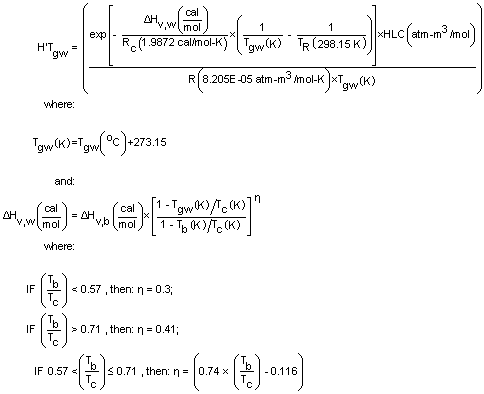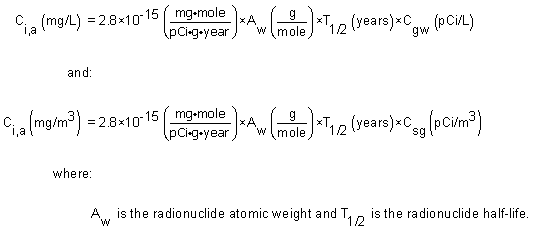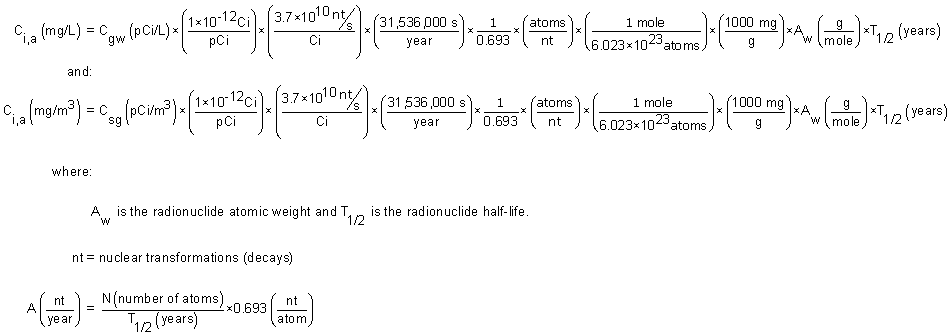page title goes here Risk Assessment
RVISL Frequently Asked Questions (FAQ)
This page presents questions asked by site users and the applicable responses. Please search this page for answers to your questions prior to contacting technical support staff. Researching the questions and answers posted here will greatly reduce the time it takes for you to solve many problems that may arise from using this calculator. The EPA has a page dedicated to radon questions.
- What are RVISLs? How are they used?
- How can I change attenuation factors?
- Why can't I calculate RVISLs using bulk soil samples?
- Can I make the RVISL calculator calculate the risk/dose/WL based on my measured data in addition to generating risk/dose/WL based screening levels?
- How can I adjust groundwater temperatures?
- How are the results converted to a mass basis?
- How are the UMTRCA working level (WL) standards converted to pCi/L?
- When do I use risk-based, dose-based, or WL screening level types?
- When should modelling instead of measurements be used for indoor radon?
- Why do the Superfund RVISL calculator risk results for 4 pCi/L of Rn-222 in air differ from the reported EPA Office of Radiation and Indoor Air (ORIA) health risks for the same activity?
- I noticed the VISL and RVISL use the same attenuation factors. Are the VISL default attenuation factors appropriate for use in the RVISL calculator?
- What are RVISLs? How are they used?
- How can I change attenuation factors?
- Significant openings to the subsurface that facilitate soil gas entry into the building (e.g., sumps, unlined crawl spaces, earthen floors) other than typical utility penetrations.
- Very shallow groundwater sources (e.g., depths to water less than five feet below foundation level).
- Significant routes for preferential, subsurface vapor migration whether naturally occurring (e.g., fractured bedrock) or anthropogenic.
- Those originating in landfills or disposal sites where radon is generated in sufficient quantities to induce advective transport in the vadose zone.
- Those originating in commercial or industrial settings where vapor-forming chemicals can be released within an enclosed space and the density of the chemicals' vapor may result in significant advective transport of the vapors downward through cracks and openings in floors and into the vadose zone.
- Leaking vapors from pressurized gas transmission lines.
- Why can't I calculate RVISLs using bulk soil samples?
- Can I make the RVISL calculator calculate the risk/dose/WL based on my measured data in addition to generating risk/dose/WL based screening levels?
- How can I adjust groundwater temperatures?
- How are the results converted to a mass basis?
- How are the UMTRCA working level (WL) standards converted to pCi/L?
- David Allen. Dose Conversion Factors for Radon WLM. Centers for Disease Control and Prevention (CDC), June 2018.
- Health Physics Society (HPS). Ask the Experts: Environmental and Background Radiation - Radon, May 2017.
- When do I use risk-based, dose-based, or WL screening level types?
- When should modelling instead of measurements be used for indoor radon?
- Why do the Superfund RVISL calculator risk results for 4 pCi/L of Rn-222 in air differ from the reported EPA Office of Radiation and Indoor Air (ORIA) health risks for the same activity?
- I noticed the VISL and RVISL use the same attenuation factors. Are the VISL default attenuation factors appropriate for use in the RVISL calculator?
Radon vapor intrusion screening levels (RVISLs) are a type of preliminary remediation goal (PRG) and both are a subset of the broad screening level (SL) category. Specifically, RVISLs are concentrations for groundwater, soil gas (sub-slab and exterior to buildings), and indoor air to assist Agency staff with making radon vapor intrusion decisions based on limited, initial data.
To change the attenuation factors, run the calculator. The main page has editable cells with the default factors presented. The soil gas attenuation factor is a ratio of the indoor air concentration to the soil gas concentration. The groundwater attenuation factor is a ratio of the indoor air concentration to the groundwater concentration times its unitless Henry's Law constant (H'). For more information on what to consider when modifying attenuation factors see section 6.5 of the User's Guide and FAQ11 for more information.
The RVISLs for groundwater and soil gas (either sub-slab gas or soil gas exterior to buildings) are calculated from the target indoor air concentrations using reasonably conservative generic attenuation factors that are empirically based, as described in the EPA's 2015 vapor intrusion guidance.
A critical assumption for this generic model is that site-specific subsurface characteristics will tend to reduce or attenuate soil gas concentrations as vapors migrate upward from the source and into overlying structures. Specific factors that may result in relatively unattenuated or enhanced transport of vapors into a building include the following:
The factors listed above may limit the usefulness of the appropriate application of the recommended attenuation factors and the sub-slab, groundwater, and soil gas VISLs for identifying sites or buildings unlikely to pose a health concern through the vapor intrusion pathway. On the other hand, further evaluation of the vapor intrusion pathway is still appropriate when the sub-slab, groundwater, and soil gas VISLs are exceeded for samples from a building or site where these specific factors are present.
VISLs should not be used for some contamination sources. Radon source types that typically make the use of the recommended attenuation factors and health-based VISLs for groundwater and soil gas inappropriate include:
In each case, the diffusive transport of vapors may be overridden by advective transport, and the vapors may be transported in the vadose zone several hundred feet from the source of contamination with little attenuation in concentration. In general, EPA recommends considering whether the assumptions made for deriving the attenuation factors are valid for a given site. If they are not valid, EPA recommends that the medium-specific RVISLs not be relied upon as a line of evidence for identifying sites or buildings unlikely to pose a health concern through the vapor intrusion pathway. Where the assumptions regarding the subsurface attenuation factors do not or may not apply, EPA generally recommends collecting indoor air samples.
Consistent with the 2015 Technical Guide for Assessing and Mitigating the Vapor Intrusion Pathway from Subsurface Vapor Sources, "bulk soil (as opposed to soil gas) sampling and analysis is not currently recommended for estimating the potential for vapor intrusion to pose unacceptable human health risk in indoor air, because of the potential for vapor loss due to volatilization during soil sampling, preservation, and analysis. In addition, there are uncertainties associated with soil partitioning calculations."
Yes, in addition to calculating SLs, the calculator allows the user to input data collected from their site. This data is used to model the indoor air concentration, calculate a chronic daily intake, and the cancer risk. On the calculator main page, select "Yes" under the section titled "Predict indoor air concentrations and risk from measured media concentrations?". A choice will be presented for the user to select between air, soil gas, and groundwater data. "Site-specific" mode is automatically activated, and the user will be prompted to enter site data.
The main page of the calculator has a cell where the groundwater-soil system temperature can be changed from the default of 25 °C to a site-specific value.
Since the unitless Henry's Law Constant (H') is derived based on the partial pressure of a gas in equilibrium with a liquid and the equilibrium changes when temperature changes, H' is changed to reflect equilibrium at the given temperature. The equation below illustrates how H' is derived when groundwater temperature is changed. An EPA Fact Sheet describing the process can be found at https://www.epa.gov/vaporintrusion/fact-sheet-correcting-henrys-law-constant-temperature.
Appendix B of the Soil Screening Guidance for Radionuclides Technical Background Document presents a formula for converting PRGs in pCi/L to mg/L. The equations are reproduced here with similar conversions for mg/m3.
The derivation of the 2.8 × 10-15 conversion is presented below.
Combination of the derivation of the conversions with the isotope-specific half-life and atomic weight is presented here.
The three green rows in this table depict the three steps to convert the UMTRCA WL standard to pCi/L. For more discussion on WLs, see the User's Guide Section 2.8.
Working Level Conversion References
Assuming Radon Equilibrium Factor (Feq) = 1 Rn-222 Rn-220 Rn-219 1 WL = 100 pCi/L 1 WL = 7.5 pCi/L 1 WL = 162 pCi/L 1 WL = 100,000 pCi/m3 1 WL = 7,500 pCi/m3 1 WL = 162,000 pCi/m3 1 WL = 3.7 Bq/L 1 WL = 0.2775 Bq/L 1 WL = 5.994 Bq/L 1 WL = 3,700 Bq/m3 1 WL = 277.5 Bq/m3 1 WL = 5,994 Bq/m3 Assuming Radon Equilibrium Factor (Feq) = 0.4 for Rn-222 and 0.02 for Rn-220 Rn-222 Rn-220 Rn-219 1 WL = 250 pCi/L 1 WL = 375 pCi/L Unable to provide
conversion due to
missing Feq from
Federal Guidance
for Rn-219.1 WL = 250,000 pCi/m3 1 WL = 375,000 pCi/m3 1 WL = 9.25 Bq/L 1 WL = 13.875 Bq/L 1 WL = 9,250 Bq/m3 1 WL = 13,875 Bq/m3 Standardized to 0.02 Working Levels (WL) Rn-222 Rn-220 Rn-219 0.02 WL = 5 pCi/L 0.02 WL = 7.5 pCi/L Unable to provide
conversion due to
missing Feq from
Federal Guidance
for Rn-219.0.02 WL = 5,000 pCi/m3 0.02 WL = 7,500 pCi/m3 0.02 WL = 0.185 Bq/L 0.02 WL = 0.2775 Bq/L 0.02 WL = 185 Bq/m3 0.02 WL = 277.5 Bq/m3
The RVISL calculator is likely to be used primarily for Applicable or Relevant and Appropriate Requirement (ARAR) compliance. For example, the UMTRCA indoor radon standards 40 CFR 192.12(b)(1) and 192.41(b) were identified as likely Federal ARARs for Rn-222 and Rn-220 in Attachment A of the EPA guidance document Establishment of Cleanup Levels for CERCLA Sites with Radioactive Contamination. There are some state standards that may be expressed in pCi/L or mrem/yr that, if more stringent than the UMTRCA standards, may be selected as ARARs. Background levels of indoor radon will typically exceed the risk range, and it would generally not be expected that remediation levels for indoor radon would be risk-based or based on background. The risk portions of the RVISL can still be used to provide risk estimates for the ARAR-based remediation levels.
Computer codes such as the RVISL, which was developed to predict hazards from potential human exposure to radon concentrations in indoor air, are based on simplified equations and protective assumptions. While RVISLs may be imprecise for an individual house or structure they are protective in nature for screening a wide variety of buildings. EPA would recommend, where possible, Regions use measurements of radon indoors rather than rely on the calculations of estimated transport in soil included in the RVISL calculator. In particular, testing of groundwater or soil gas is not required to demonstrate compliance with RVISL WL, pCi/L, risk, or dose targets.
The RVISL calculator risk results for 4 pCi/L of Rn-222 in air differ from the reported ORIA health risks for the same activity for several reasons. The first is that the RVISL calculator uses risk coefficients based on morbidity (getting cancer) from inhalation and submersion exposure routes, while the ORIA tables are based on mortality (death) from inhalation-induced lung cancer only. The ORIA Health Risk of Radon web page reports that for smokers and never-smokers, the mortality risk from lung cancer of 4 pCi/L of Rn-222 is 62 out of 1,000 people and 7 out of 1,000 people, respectively, or 6.2 x 10-2 and 7 x 10-3. Given in the scientific notation format used in the RVISL, this relates to a lung cancer mortality risk of 6.2E-02 and 7E-03, respectively. The RVISL calculates residential risk results for a combination of smokers and never-smokers to 4 pCi/L of Rn-222 in air is 8.39E-02, which rounds to 8.4 x 10-2. Additionally, the ORIA risk estimates are based on an average population study, where the individual's exposure parameters are not considered, while the RVISL calculator results are based on a reasonably maximum exposed (RME) individual. The individual exposure parameters considered in Superfund assessments include dwelling air exchange rate, inhalation rates, exposure duration, and resident time indoors.
For more information on different methods for making radon inhalation cancer risk estimates see section 2.3.1 of the User Guide.
The default VISL attenuation factors are also used in the RVISL. In fact, radon intrusion studies were the foundation for recognition that chemical vapors also intrude into buildings and enclosed spaces from soil and groundwater sources (EPA 1995). It was also observed that vapor intrusion mitigation remedies suppress both chemical and radon gasses and that monitoring radon intrusion is a viable surrogate for predicting chemical intrusion susceptibility in buildings (EPA 2015). Many studies reported in EPA 2012a, demonstrate strong correlation between radon and chemical sub-slab soil gas attenuation factors calculated when the radon and chemicals are uniformly distributed.
The default attenuation factors can be substituted with site-specific attenuation factors if underlying site conditions are known. EPA 2012b presents site-specific attenuation factors for sub-slab soil gas, groundwater, and crawlspaces for chemicals. The attenuation factors are summarized in the following table. The defaults used in the VISL and RVISL calculators are highlighted. The defaults are based on the 95th percentile and are appropriate for adjusting an RME scenario. The 50th percentile values would be more appropriate for a central tendency exposure scenario where a large amount of sampling data is available to reduce uncertainty in calculating the exposure concentration or defining nature and extent of the source term.
Subslab Soil Gas Attenuation Factors Residence Type Median (50th percentile) 95th Percentile All residences 3E-03 (0.003) 3E-02 (0.03)* Residences with basements 3E-03 (0.003) 3E-02 (0.03) Residences with slab-on-grade 3E-03 (0.003) 1E-02 (0.01) Groundwater Attenuation Factors Scenario Median (50th percentile) 95th Percentile All soil types and water depths 7E-05 (0.00007) 1E-03 (0.001)* Fine soil type 5E-05 (0.00005) 5E-04 (0.0005) Coarse soil type 1E-04 (0.0001) 1E-03 (0.001) Very coarse soil type 2E-04 (0.0002) 4E-03 (0.004) Depth to water < 1.5 m 6E-04 (0.0006) 7E-03 (0.007) Depth to water 1.5-3 m 1E-04 (0.0001) 2E-03 (0.002) Depth to water 3-5 m 4E-05 (0.00004) 2E-03 (0.002) Depth to water > 5 m 5E-05 (0.00005) 6E-04 (0.0006) Exterior Soil Gas Attenuation Factors Scenario Median (50th percentile) 95th Percentile All residences 4E-03 (0.004) 3E-01 (0.3) Crawlspace Attenuation Factor Scenario Median (50th percentile) 95th Percentile All residences 4E-01 (0.4) 9E-01 (0.9) *These values are the VISL and RVISL defaults.




